Camping In the Yard

Parked in December 2013, the 22-foot camping trailer I purchased as my temporary home while I built the house required considerable modification to make it suitable for year-round habitation—after all, they're really only built for occasional use, usually during temperate weather. Also, it was designed to sleep seven, and since I was living in it alone, it didn't quite suit my needs as well as it could with some tinkering. Here's how it started:
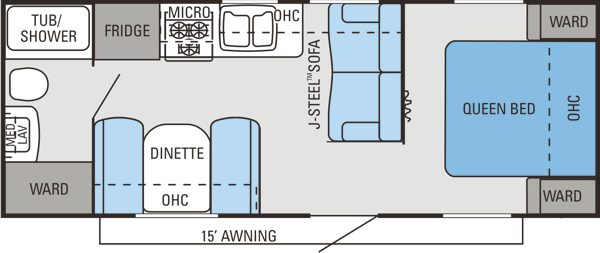
And here's what it looked like when I was done:
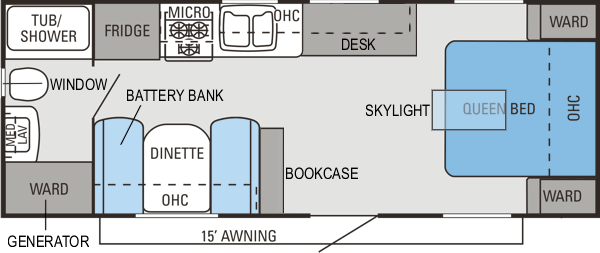
First, I tore out the sofa, along with the wall behind it, which separated the bed from the rest of the camper (before, below left). In place of the sofa I built a desk, complete with computer stand—actually a new furnace enclosure—and slide-out keyboard tray (after, below right).


In addition to relieving the camper's generally cramped, claustrophobic atmosphere (before, below left), removing the sofa created the space to add a small bookcase, which I attached to the back of one of the dinette seats (after, below right).



With no access to electricity, I had to make significant modifications to the camper's electrical system, which was really only able to operate without plug-in power for maybe a half-hour at most—seriously. The all-new system I designed began with a 2800-watt generator, which I permanently installed in what was once a small, externally-accessed storage compartment beneath the bathroom wardrobe (below left), with an air vent cut into the door, and an exhaust stack added to the outside corner to carry fumes well above the camper. Also, I installed a 28-gallon marine gas tank in a small indoor storage space wedged in between the generator compartment and the wardrobe above it, with a filler added to the back of the camper (visible in the large snow scene below). The generator was never intended to be run continuously; instead, its sole purpose was to charge a bank of sealed batteries I installed under one of the dinette seats (below right).


The batteries powered the camper through a charger/inverter unit installed in the cabinet under the bathroom sink (below left), and an outdoor shower fixture right behind it was replaced with a cooling fan and vent. The system controls were mounted in a cluster on the side of the bathroom cabinet (below right), which included the inverter control, the generator starter, and the gas gauge; a generator runtime clock was mounted around the corner to the left, out of frame. Depending on electrical demand, I'd need to run the generator between one and three hours a day; at maximum use, the gas tank had to be refilled about once a month. To conserve as much energy as possible, I replaced every single light fixture in the camper—which, surprisingly, were all tungsten—with LEDs.


The battery system was carefully monitored via a display mounted below the thermostat in the kitchen, where it was easily visible from anywhere in the camper (below left); it displayed the battery charge and approximate hours remaining. I also added three 120-volt outlets for the computer, printer and TV, and a 12-volt outlet for a window fan. The system was designed so that I could utilize the 12- and 120-volt supplies simultaneously or independently as needed to maximize efficiency. Meanwhile, the two small propane tanks that came with the camper were disconnected, and a jumbo tank took their place (below right), which supplied enough gas for at least a full month in the dead of winter.



To reduce the load on the furnace, I installed a substantial amount of rigid foam insulation and weather-stripping in every space I could access, including under and behind the bed, beneath the floor, and inside all of the outside-accessed storage compartments. But even with all of this, there were times when the furnace ran full-time, barely keeping the camper at 60 degrees—clearly the system was taxed beyond its design limits.

I also had to add insulation around the water storage tanks, which were exposed beneath the camper, so they wouldn't freeze (which they had a couple of times before adding the insulation). Because weather was always a concern, I purchased a little weather station to monitor conditions, and installed a ladder so I could access the roof to keep it clean.
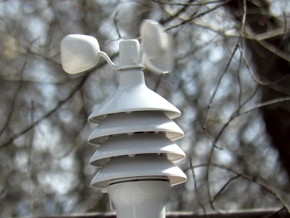

I made numerous smaller functional and cosmetic changes. For instance, I installed a skylight over the bed (below left) and a small porthole window in the bathroom (below right) to increase natural light. The skylight made an enormous difference, while the porthole window provided a view of the driveway I didn't have before.


There was a small unused space over the microwave, which I converted into a spice rack (below left), and I installed a paper towel holder over the sink (out of view), although after the arrival of my grandchildren, I had to keep the paper towels locked up, as they loved to unroll them. I also added a little wine rack/glass holder over the dinette, just for kicks (below right).


Since the wardrobe in the bathroom was more than adequate for any clothes I needed to hang, I added shelves in the wardrobes beside the bed to create more useable storage space (below left). And I added a small shelf over the computer desk (below right) where I kept a clock and a few dust collectors.


The camper came with an elaborate audio/video system, including a TV, DVD player and stereo receiver. I moved the TV from the kitchen to a new wall mount I added beside the bed, ripped out the stereo, and replaced the four ceiling-mount speakers with recessed LED ceiling light fixtures (visible in the photo of the skylight over the bed, above). The audio/video unit occupied a space over the dinette, which I converted into another storage cabinet (below left), with a switch to control the ceiling lights just to the right. I installed my own entertainment center in one of the cabinets beside the bed (below right), but I wound up rarely using it because it was an energy pig.

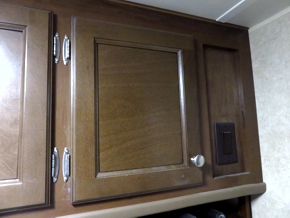
The bed was originally designed to cover a large storage space underneath, which was accessed by lifting the bed frame. This was not only impractical, but the bed frame was structurally unsound. Plus, there was no separation between the storage space under the bed and an externally-accessed storage space behind it, which resulted in significant heat loss. I completely rebuilt the bed with a solid, fixed base, separated the internal and external storage areas, and added a cabinet door at the foot of the bed to access the interior storage space.

Other cosmetic changes included all-new flooring, which you can see in the view above (taken a few months after the arrival of my furry grandchildren), new door hardware, new battery-powered under-cabinet lights, and other subtle touches. I also installed a driveway sensor to detect visitors long before they arrived, which proved to be a very useful security device—I was able to greet a number of trespassers before they even stopped their cars. And I installed several battery-powered motion-activated lights all around the camper.
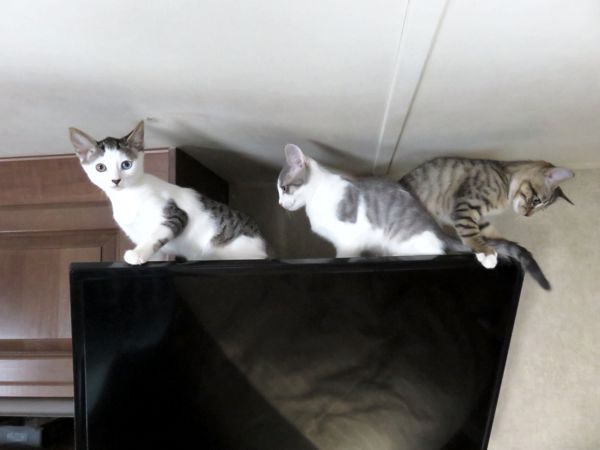
Speaking of my cats, they heralded a new phase of my life in the camper, one that might be characterized by a more typically "domestic" appearance—i.e., a bit cluttered. But that didn't bother me in the slightest; they were my joy. They inspired me to make changes just for them, such as building a window box that I mounted over the kitchen window. They absolutely loved it in the summertime.
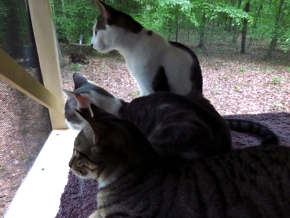
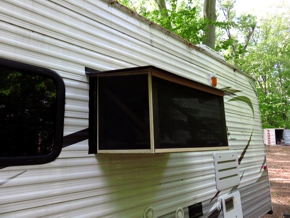
Originally the screen door could be opened just by pushing on it, and it wasn't spring-loaded to close itself, so I built a new latching system and added a spring so they could be left alone inside with the outer door open. I called it the "kitty entertainment system."

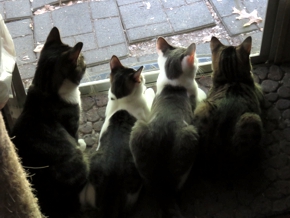
When I moved into the cabin, the camper became their exclusive domain. I'm sorry to say, consequently, they've ruined things like the bed, window treatments and screens, but that's only because I wasn't with them full-time to monitor their activity, and I love them no less for what they did; they're just cats being cats.

Thus the camper became a very depressing place—not because of its condition, but because it was a constant reminder that my kids weren't living in the house with me. My kids were finally moved out of the camper on 25 December 2019.

Then, on 9 June 2020, the camper was moved to the driveway next to the garage where it could easily be taken away, exposing land that had not seen sunlight since December 2013. Now all of the work I'd put into the camper, and the year I'd spent living in it, are memories I don't care to recall. Also see Then, Then and Now.

Incidentally, the camper has a new owner as of early July: my postal delivery person and her husband took it, fully understanding it needs to be completely rebuilt. Good for them.
